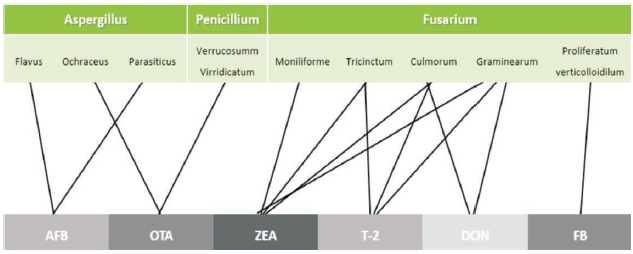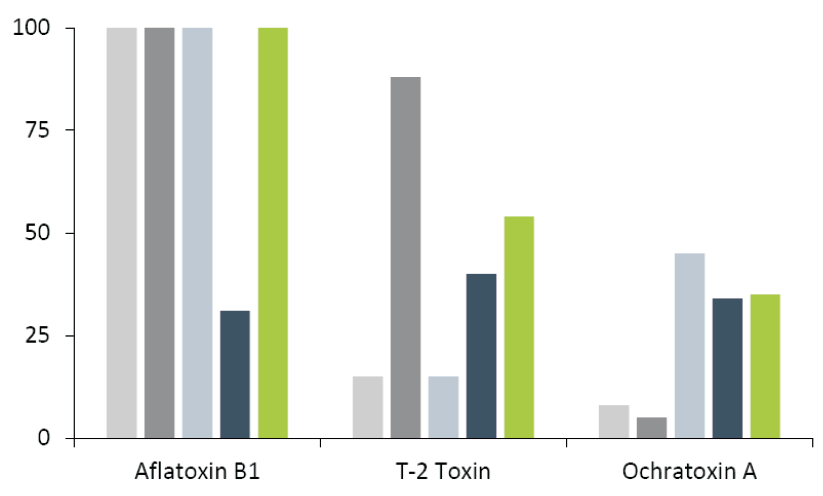Molds and their mycotoxins pose a problem for feeds despite high quality standards. Various analyses have shown that a large proportion of feed samples are contaminated with two or more mycotoxins. The risk of diseases associated with exposure to mycotoxins, so-called mycotoxicosis, is rising rapidly. Although acute mycotoxin poisoning is a relatively rare occurrence, a subclinical mycotoxicosis is much more common but oftentimes overlooked. In times of high feed prices, this threat to animal performance can be eliminated easily through the right choice of a mycotoxin binder. Here are 3 reasons why you should invest in a quality product.
- The threat is real
It is currently estimated that there are several hundred mycotoxins. They are an unavoidable occurrence in feed on a global level, 30 – 100 % feed samples are co- contaminated. The FAO estimates that 25 % of the world’s food crops are affected, but other surveys assume much higher contamination rates, especially for regions in warm and humid climates.
Several molds can produce more than one mycotoxin at a time (figure 1). These co-contaminations can severely impact animal health. Among the most important mycotoxins in agriculture are surely the aflatoxin B1 Aspergillus toxin (AFB1); the ochratoxin A Penicillium toxin (OTA); the zearalenone (ZEA), deoxynivalenol (DON), and fumonisin B1 (FB1) Fusarium toxins; and the T2-toxin. Synergistic effects occur when the combined effects of two mycotoxins are higher than the individual effects of each toxin alone. For example, the negative impact of the combined presence of DON and T2-toxin, both produced by the same Fusarium molds, is higher than the effect of each toxin alone.

Figure 1: Co-contaminations can multiply harm due to synergistic effects
The clinical appearance of mycotoxicosis in the field may have many faces. Starting with damaging impacts on cellular level, mycotoxins are known to:
• Inhibit protein biosynthesis
• Modulate immune response
• Induce oxidative stress and membrane damage
• Cause liver- and neurotoxicity
The sum of these cellular damages is manifested in reduced biological performance, such as decreased weight gains, productivity, and impaired fertility.
Animals will become more susceptible to (secondary) infectious diseases and other health impairments.
- Targeted Multi-toxin binding efficiency
Mycotoxins display a wide range of structures, varying extremely concerning their physical and chemical properties. The binding agent must be adapted to the mycotoxin. This cannot be achieved through a hit- and-miss tactic: product development is highly specific and decisive for an effective mycotoxin binder. Due to the high risk of co-contaminations, effective mycotoxin binders must further be developed to bind as many of these different mycotoxin structures as possible.
Many mycotoxin binders are mainly based on various layered silicates (phyllosilicates), such as bentonite, kaolinite, sepiolite, or vermiculite, the framework silicates (tectosilicates) like clinoptilolite (zeolite), and amorphous silica such as kieselguhr (diatomaceous earth). At first glance, the differences between the various types of silicates seem only marginal. However, surface treatment and pore structures also have an impact on a raw materials’ efficacy. The Biochem laboratory studies clearly show that significant differences in the binding behavior of these minerals can be detected. Based on this research, Biochem developed the B.I.O.Tox® portfolio of mycotoxin binders.
As each toxin binder ingredient has its binding affinity towards certain mycotoxins, a combination of different ingredients is essential for a broad binding spectrum. To find the ideal ingredient combination, it is important to evaluate the binding properties for each component as well as their combination (figure 2). - Confirmed efficacy

This great binding efficiency has been verified by a multitude of in vitro studies in various independent laboratories. The efficiency of B.I.O.Tox® with respect to such mycotoxins as zearalenone, T-2 toxin, ochratoxin A, and fumonisin B1 was significantly higher than several tested competing products.
But in vitro studies alone do not make a great toxin binder. An extensive collection of in vivo scientific and field studies with demonstrate the capability of B.I.O.Tox® to prevent the manifestation of mycotoxicosis in the presence of various toxins. The biological performance of the animals was maintained. These effects make B.I.O.Tox® an efficient tool for controlling mycotoxin risk and maintaining biological performance and farm profitability!
Conclusion
In the face of rising raw material prices and increasing economic pressure, preventing the detrimental impacts of mycotoxins is decisive for successful animal production. A broad range of products is available on the market. To make you choice for effective
mycotoxin management, these three points should be considered:
> A quality mycotoxin binder needs an extended binding spectrum
> An effective mycotoxin binder has well proven binding properties
> Extensive documentation confirms both in vitro and in vivo efficacy
B.I.O.Tox® is a quality toxin binder that is up to the task, allowing your animals to perform their best while you do not need to worry about the economic impact of possibly contaminated feed materials.